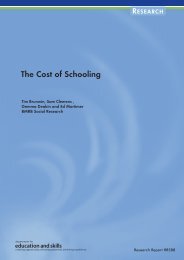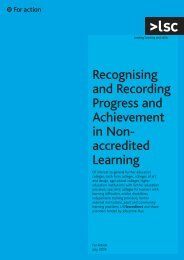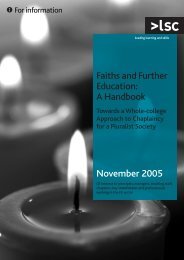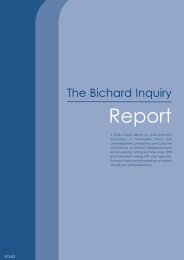Parents' Experiences of the Process of Choosing a Secondary School
Parents' Experiences of the Process of Choosing a Secondary School
Parents' Experiences of the Process of Choosing a Secondary School
Create successful ePaper yourself
Turn your PDF publications into a flip-book with our unique Google optimized e-Paper software.
comprehensive, still test children <strong>the</strong> year before so <strong>the</strong>y can set <strong>the</strong>m so<br />
you’ll end up doing tests come what may, more or less whatever school you<br />
wanted your child to go to.<br />
6.6 Applying for places at a selective school<br />
In some areas all children in <strong>the</strong> last year <strong>of</strong> primary school are entered for <strong>the</strong> test<br />
with parents able to withdraw <strong>the</strong>m by request. This method <strong>of</strong> entry is common for<br />
wholly selective areas and provides universal access and raises no obvious equity<br />
issues beyond those generally associated with selective systems. In o<strong>the</strong>rs children<br />
are entered on <strong>the</strong> primary school’s recommendation with parents able to include<br />
<strong>the</strong>m by request. This involves, as a formal part <strong>of</strong> <strong>the</strong> process, a discussion with<br />
primary school staff about <strong>the</strong> child’s secondary education and raises issues about<br />
<strong>the</strong> status <strong>of</strong> primary schools’ judgements and <strong>the</strong> possibility that parents will differ<br />
in how <strong>the</strong>y act on that recommendation. In o<strong>the</strong>r LEAs parents may request that<br />
<strong>the</strong>ir child take <strong>the</strong> test, for example when <strong>the</strong>y must make application to <strong>the</strong><br />
schools <strong>the</strong>mselves. Again this requires parents to be pro-active and <strong>the</strong>re may be<br />
differences in parents’ understanding <strong>of</strong> how to use <strong>the</strong> system.<br />
6.7 <strong>School</strong>s that use partial selection<br />
Partially selective schools are those which select a proportion <strong>of</strong> pupils entering <strong>the</strong><br />
schools. Two grounds for selection are identified in <strong>the</strong> <strong>School</strong> Standards and<br />
Framework Act 1998 (Chapter 2 s 99 to 103). The grounds are selection on <strong>the</strong><br />
basis <strong>of</strong> general ability and selection on <strong>the</strong> basis <strong>of</strong> aptitude for one or more<br />
subjects. Arrangements for partial selection that were in place in <strong>the</strong> 1997-1998<br />
school year are authorised providing <strong>the</strong>y have remained unchanged since that time.<br />
However, objections to such arrangements can be made and this is <strong>the</strong> most<br />
frequent type <strong>of</strong> objection that <strong>the</strong> <strong>School</strong>s Adjudicator has to deal with.<br />
In almost all partially selective schools testing is carried out by <strong>the</strong> school. The<br />
issue for parents in choosing a partially selective school as <strong>the</strong>ir first preference is<br />
firstly, <strong>the</strong> uncertainty <strong>of</strong> whe<strong>the</strong>r <strong>the</strong>ir child will be successful in gaining a<br />
competitive place at a selective school and secondly, <strong>the</strong> implications <strong>of</strong> not gaining<br />
a place at such a school for <strong>the</strong> remaining choices available to <strong>the</strong> parent.<br />
6.8 The composite prospectuses from all 141 authorities were examined and all schools<br />
(community, foundation and voluntary-aided) mentioned in <strong>the</strong> prospectuses as<br />
operating partial selection by aptitude or ability in 1999/2000 were recorded. Since<br />
a single school may <strong>of</strong>fer up to three kinds <strong>of</strong> specialism <strong>the</strong> table records <strong>the</strong><br />
distribution <strong>of</strong> <strong>the</strong> number <strong>of</strong> specialisms within different LEAs and not <strong>the</strong> number<br />
<strong>of</strong> schools. The category ‘general ability’ means those places allocated on <strong>the</strong> basis<br />
<strong>of</strong> a test for general ability.<br />
47

















